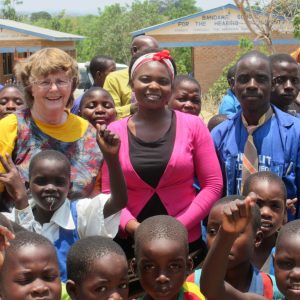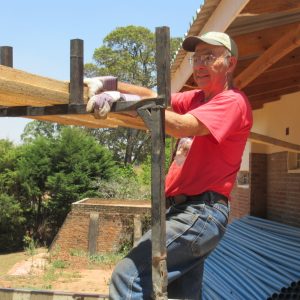This story originally appeared in the July 2019 edition of the CSU Alumni Association’s Alumline
For more than 20 years Carol (B.A. Speech Arts, ’67) and Jim Nussbaumer (B.S. Electrical Engineering, ’67; M.S. Electrical Engineering, ’78; M.S. Computer Science, ’92) have traveled from their Estes Park, Colo., home to Embangweni, Malawi, for weeks at a time, to reunite with friends, plug into purposeful work, and witness the steady transformation of a community. That the couple ever made their way from Colorado to Malawi is kind of a miracle.

Carol would be the first to emphatically tell you, “I don’t do mission.”
Born and raised in Estes Park, a lifelong Presbyterian, quilter, and witty introvert, Carol is averse to airplane travel. Cultures and food other than her own neither excite nor intrigue. Then there’s her family history.
“I had a great-aunt who was a missionary in Egypt for 40 years, through a period of civil unrest in 1919 (siege of Assiut), and an uncle who was a missionary in rural Kentucky in the 1930s,” Nussbaumer says. “He died there due to lack of medical care. I figured that was enough mission for one family.”
After navigating their way through the complexities of military assignments and life during the Vietnam War – they lived in California, Texas and Maryland – Carol and Jim settled in Loveland, Colorado, and raised their daughters Pam and Cindy. Jim worked at Hewlett Packard. Carol had a speech therapy practice.
When she retired in 1995, her plan was to become a professional quilt maker.
But later that same year Carol learned through her church that the Embangweni Mission Hospital in Malawi, Africa, needed medical facilities help. It was unlikely Carol could be of service but, as she says, following the presentation she “uncharacteristically” offered her time, in person and through a letter, to the Medical Benevolence Foundation staff who supported the mission work.
They finally responded that the Embangweni School for the Deaf, located near the hospital at the Loudon Mission Station, could use her speech therapy expertise. She knew very little about deaf culture in Africa, let alone Malawi. But she did know how to work with pre-K nonverbal children. Now that was intriguing. Except she didn’t want to go. She, after all, does not “do mission.”
But then, you know, just out of curiosity, she casually dropped into a travel agency to see how one would get to Malawi: the agent’s massive resource book fell open to Lilongwe, the capital city. Next, Jim found a forgotten insurance policy paid up in the exact amount of the airfare to Lilongwe.
Then the clincher: a blurb included in the Embangweni hospital newsletter Carol had started to receive stated: “One of our biggest needs right now is quilts for kids who are dying of hypothermia.”
Carol got the message loud and clear. “I knew it was a call because I didn’t want to go,” Carol says, “but I went anyway.” It was 1997. She planned to go for three months because it seemed like the right length for her first and only mission trip.
Jim, who had a stockpile of vacation time (he retired from HP in 2000), went too. “He didn’t want to eat his own cooking for that long,” Carol says with a wry grin.
From one sign to another
Located in the village of Embangweni in northwest Malawi, the Loudon Mission Station was founded in 1902 by Scottish missionaries Reverend Donald Fraser and his wife Dr. Agnes Fraser. The station is one square mile, and today houses a hospital, church, primary and secondary schools for both hearing and the deaf.

When Carol and Jim arrived in 1997, modern amenities were minimal to none. No electricity. No internet. No vehicles (except for emergency services at the hospital). The computer was solar-powered. The primary school for the deaf had been open just two years and it was severely under resourced.
Carol credits her liberal arts education at CSU for teaching her to problem solve her way out of this and other constraints. She made mini flashcards by tearing her business cards into quarters. She found that her Malawian-educated colleagues were less comfortable “thinking outside the box.”
But they weren’t entirely set in their ways. Among one of the greatest impacts Carol made during her first visit was to assist the faculty in learning some basic sign language. “The teachers did not know sign because the thinking at the time was, ‘if you teach a deaf child to sign, she will never learn to speak and will be seen as different in the village.’”
Yet communication is an inherent need. Deaf students had already developed gestures between themselves, but there was no consistency. “In 1997 there were four classes of students and four different ‘signs’ for flashlight,” Carol says.
Although her own knowledge of sign was small, she did know the alphabet and began after school teacher workshops. Older students eventually saw Carol practicing sign with the school Head and before long they were learning the alphabet too. Shortly after Carol returned to Colorado, the school began to develop its own sign system, which continues to evolve.
Far from shallow
There wasn’t a map of the station grounds – Carol kept getting lost the first day – so he made one. Apart from Carol and nine 75–pound plastic bins full of medical supplies and other necessities, Jim arrived in Malawi with some tools, his laptop, and an 8mm camera. Despite his lack of official mission assignment, Jim is not one to sit idle.
He learned about a new yet uninstalled windmill that sat parted out in a maintenance shed. It had been donated by a church in Nebraska but the initial installation was in a poor location and the project was abandoned. Jim adopted it, identifying what was missing, ordering new parts (delivery from the U.S. took more than 3 weeks), and eventually guiding its successful installation at a nearby medical clinic.
Jim got to know the hospital plumber Henry Soko, or Mr. Soko as he was respectfully called. Soko was also in charge of a crew of men who manufactured pumps that were used in nearby shallow wells. The wells could generate enough clean water to serve 150 or so people – the size of a small village.
Unlike a bore hole, which is a machine-drilled well that descends 50 to 200’, costs $5–10,000, and often requires highly technical maintenance (many an unrepaired bore hole sits idle in Malawi), shallow wells are hand dug by the villagers to a depth no greater than 20’ and (in 1997), cost $300 to build, and can be maintained in country by local experts.

In 1997, Loudon Mission Station was the hub of the U.S.-based Marion Medical Mission (MMM) shallow well program in northern Malawi. Easy access to clean water means families aren’t sharing water holes with animals. Additionally, the time that women and children formerly spent traveling long distances to acquire water – an often–unsafe prospect, as well as physically demanding (five gallons of water weighs 40 pounds) – can now go into other activities. For children, that means more time in school, or, in many cases, going to school for the first time.
One day Jim and Carol walked to a nearby village with Stephen Zulanga, a hospital maintenance worker, to see the shallow well that his village had installed. Zulanga proudly showed them the well at work, saying, “My babies don’t die anymore.”
In befriending Soko and Zulanga, Jim discovered a purpose that hooked him. Soko wanted a CAD drawing of the pumps they manufactured, so Jim got to work with measurements and design. The program had no technical manual for well installation, so Jim created one, even outsourcing most of the drawings he wanted to include to CSU students by way of Carol’s nephew, Robert Work, a design and merchandising instructor and son of retired English professor James Work. All of the drawings are still in use today, through multiple revisions of the manual.
The work is never finished
Carol’s grand vision to go to Malawi just once was ultimately thwarted. Jim returned in 1999 to volunteer with MMM for three weeks. In 2000 Carol resumed her volunteer work at the School for the Deaf. The couple has returned every year since. They stay for six to seven weeks.
With no expectation, Carol and Jim ultimately got hooked by the people, forged friendships, and made everlasting bonds. The number of contributions they have made to the Embangweni Schools for the Deaf – a secondary school opened in 2014 – and the shallow well program are countless, but not the point, they say.

What matters to them most is the success they’ve watched their colleagues and friends achieve.
The shallow well program has spread across three countries, annually installing nearly 3,000 wells (now costing $450 each).
Deaf students learn with E-readers.
Fannie Singini surpassed everyone’s expectations of what a deaf person can do by completing secondary school with no signing teachers and even becoming a teacher herself. She is a product of what the school teaches its children: “deaf is not death” and “disability is not inability.”
And, modern amenities have improved: electricity and the internet finally arrived.
Carol and Jim have each found ample room inside their volunteer work to create new systems, encourage and foster the professional growth of their colleagues, engage the time, treasure and talents of other U.S. volunteers, and deepen their service.
“This is a project that is never finished,” Jim says, referring to the shallow wells. “Admittedly, it’s a feeling of purpose. A feeling that is hard to replace.”